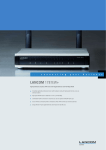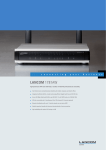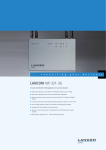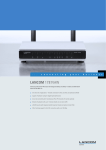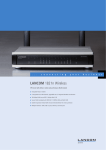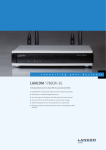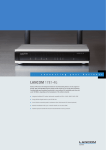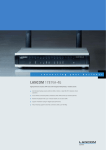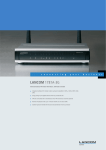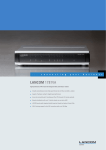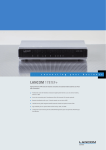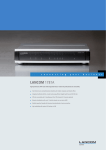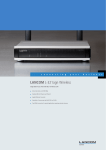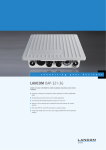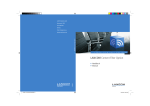Download Lancom Systems 1781EW
Transcript
The LANCOM 1781EW professional VPN router is ideal for setting up modern corporate networks: This versatile device connects to various types of modems and, with its
integrated dualband WLAN module, it provides wireless networking for clients as per IEEE 802.11 a/b/g/n. Thanks to the longer ranges available from 802.11n technology,
additional access points often become unnecessary. An extensive range of VPN functions enable branch offices and mobile workers to access the company network securely
and at high speeds. The four ports of the integrated Gigabit Ethernet switch ensure maximum performance and are also energy-efficient as per IEEE 802.3az: If no data
is transmitted over an interface, the power consumption shuts down automatically. The LANCOM 1781EW supplies everything that a modern enterprise network needs,
such as comprehensive Quality-of-Service capabilities and an object-oriented firewall.
More Performance
The LANCOM 1781EW provides a balanced and modern hardware platform for reliable operation of enterprise networks around the clock. As a professional business
router, the device meets with high standards in the areas of network virtualization, security and VPN networking. At the same time its computing power, storage capacity
and the high-speed interfaces ensure excellent network performance even with heavy data traffic. And the integrated 300-Mbps wireless LAN module takes this performance
to wireless clients as well.
More Security.
For connecting to home offices or setting up multi-national branch networks: VPN specialist LANCOM stands for fast, secure and cost-effective communications. The
LANCOM 1781EW is ideal for offices or small businesses that want to set up a secure VPN: The router's VPN gateway supports five simultaneous IPSec channels, with
support for 25 channels as an optional extra. Secure wireless LAN with the LANCOM 1781EW is assured by its support of a wide range of security standards such as IEEE
802.1i (WPA2), 802.1X and WEP encryption. Thanks to multi-SSID, the wireless LAN supports multiple networks that are securely separated from one another. Optionally
available, the LANCOM Content Filter protects up to 100 users effectively while surfing the World Wide Web. Flexible bandwidth management guarantees the availability
of all applications (also in local networks) as these can be prioritized with a comprehensive range of Quality- of-Service features.
More Management.
LCMS, the LANCOM Management System, is a free software package for the LANCOM 1781EW. It caters for the configuration of the device, remote maintenance and
network monitoring. The central component of LCMS, LANconfig, is used to configure the LANCOM 1781EW and other LANCOM devices on the network. The extensive
range of features and the configuration wizards make the router quick to set up. LANmonitor offers detailed, real-time monitoring of parameters, it provides access to log
files and statistics, and it can carry out a detailed trace-protocol analysis. Other functions in LCMS include the GUI for firewall setup, automatic backup of configurations
and scripts, and the intuitive folder structure with convenient search function.
More Virtualization.
The LANCOM 1781EW helps you to use your IT resources more effectively and to save costs. The device simultaneously supports multiple independent networks. This is
made possible by the powerful technology Advanced Routing and Forwarding (ARF). The ARF function on the LANCOM 1781EW provides up to sixteen virtual networks,
each with its own settings for DHCP, DNS, routing and firewall. ARF allows multiple separate networks for different groups and applications to be operated on a single
physical infrastructure.
More Reliability for the Future.
LANCOM products are designed for a product life of several years and are equipped with hardware dimensioned for the future. Even reaching back to older product
generations, updates to the LANCOM Operating System—LCOS—are available several times a year, free of charge and offering major features. LANCOM offers unbeatable
safeguarding of your investment.
LANCOM 1781EW
Features as of: LCOS 8.60
WLAN
Frequency band 2.4 GHz or 5 GHz
2400-2483.5 MHz (ISM) or 5150-5825 MHz (depending on country-specific restrictions)
Data rates 802.11b/g
54 Mbps to IEEE 802.11g (fallback to 48, 36 , 24, 18, 12, 9, 6 Mbps, Automatic Rate Selection) compatible to IEEE 802.11b (11, 5.5, 2, 1 Mbps,
Automatic Rate Selection), 802.11 b/g compatibility mode or pure g or pure b
Data rates 802.11a/ h
54 Mbps (fallback to 48, 36 , 24, 18, 12, 9, 6 Mbps, Automatic Rate Selection), fully compatible with TPC (adjustable power output) and DFS
(automatic channel selection, radar detection) according to ETSI EN 301 893 V.1.5.1., EN 302 502
Data rates 802.11n
300 Mbps according to IEEE 802.11n with MSC15 (Fallback to 6,5 Mbps with MSC0)
Range 802.11a/b/g *
Up to 150 m (up to 30 m in buildings) *
Range 802.11n
Up to 250 m @ 6.5 Mbps (up to 20 m @ 300 Mbps indoor)*
Output power at radio module, 2.4 GHz
802.11b: +18 dBm @ 1 and 2 Mbps, +18 dBm @ 5,5 and 11 Mbps 802.11g: +18/19 dBm @ 6 up to 36 Mbps, +18 dBm @ 48 Mbps, +17 dBm @
54 Mbps 802.11n: +19 dBm @ 6,5 and 13 Mbps (MCS0/8, 20 MHz), +13 dBm @ 65 and 130 Mbps (MCS7/15, 20 MHz), +17 dBm @ 15/30 Mbps
(MCS0/8, 40 MHz), +13 dBm @ 150/300 Mbps (MCS7/15, 40 MHz)
Output power at radio module, 5 GHz
802.11a/h: +16 bis +17 dBm @ 6 up to 24 Mbps, +16 bis +17 dBm @ 36 Mbps, +9 up to +15 dBm @ 54 Mbps 802.11n: +14 bis +17 dBm @
6,5/13 Mbps (MCS0/8, 20 MHz), +5 up to +9 dBm @ 65/130 Mbps (MCS7/15, 20 MHz), +12 up to +16 dBm @ 15/30 Mbps (MCS0/8, 40 MHz), +5
up to +9 dBm @ 150/300 Mbps (MCS7/15, 40 MHz)
Max. radiated power (EIRP), 2.4 GHz band
802.11b/g: Up to 20 dBm / 100 mW EIRP (transmission power control according to TPC)
Max. radiated power (EIRP), 5 GHz band
802.11a/h: Up to 30 dBm / 1000 mW or up to 36 dBm / 4000 mW EIRP (depending on national regulation on channel usage and subject to further
obligations such as TPC and DFS)
Minimum transmission power
Transmission power reduction in software in 1 dB steps to min. 0.5 dBm
Receiver sensitivity 2.4 GHz
802.11b: -91 dBm @ 11 Mbps, -93 dBm @ 1 Mbps, 802.11g:, -94dBm @ 6 Mbps, -80dBm @ 54 Mbps 802.11n: -94 dBm @ 6,5 Mbps (MCS0, 20
MHz), -77 dBm @ 65 Mbps (MCS7, 20 MHz), -94 dBm @ 13 Mbps (MCS 8, 20 MHz), -77 dBm @ 130 Mbps (MCS15, 20 MHz), -89 dBm @ 15 Mbps
(MCS0, 40 MHz), -73 dBm @ 150 Mbps (MCS7, 40 MHz), -89 dBm @ 30 Mbps (MCS8, 40 MHz), -73 dBm @ 300 Mbps (MCS15, 40 MHz)
Receiver sensitivity 5 GHz
802.11a/h: -94 dBm @ 6 Mbps, -77 dBm @ 54 Mbps 802.11n: -93 dBm @ 6,5 Mbps (MCS0, 20 MHz), -74 dBm @65 Mbps (MCS7, 20 MHz), -93
dBm @ 13 Mbps (MCS8, 20 MHz), -74 dBm @ 130 Mbps (MCS15, 20 MHz), -90 dBm @ 15 Mbps (MCS0, 40 MHz), -72 dBm @ 150 Mbps (MCS7,
40 MHz), -90 dBm @ 30 Mbps (MCS8, 40 MHz), -72 dBm @ 300 Mbps (MCS15, 40 MHz)
Radio channels 2.4 GHz
Up to 13 channels, max. 3 non-overlapping (2.4 GHz band)
Radio channels 5 GHz
Up to 26 non-overlapping channels (available channels and further obligations such as automatic DFS dynamic channel selection depending on
national regulation)
Roaming
Seamless handover between radio cells, IAPP support with optional restriction to an ARF context, IEEE 802.11d support
WPA2 fast roaming
Pre-authentication and PMK caching for fast roaming
Fast client roaming
With background scanning, moving LANCOM 'client mode' access points pre-authenticate to alternative access points which offer a better signal
before Roaming fails
VLAN
VLAN ID definable per interface, WLAN SSID, point-to-point connection and routing context (4094 IDs) IEEE 802.1q
Dynamic VLAN assignment
Dynamic VLAN assignment for target user groups based on MAC addresses, BSSID or SSID by means of external RADIUS server.
Q-in-Q tagging
Support of layered 802.1Q VLANs (double tagging)
Multi-SSID
Simultaneous use of up to 8 independent WLAN networks per WLAN interface
IGMP snooping
Support for Internet Group Management Protocol (IGMP) in the WLAN bridge for WLAN SSIDs and LAN interfaces for specific switching of multicast
packets (devices with integrated WLAN only). Automated detection of multicast groups. Configurable action for multicast packets without registration.
Configuration of static multicast group members per VLAN ID. Configuration of query simulation for multicast membership per VLAN ID
Security
IEEE 802.11i / WPA2 with passphrase or 802.1X and hardware-accelerated AES, closed network, WEP64, WEP128, WEP152, user authentication,
802.1x /EAP, LEPS, WPA1/TKIP
RADIUS server
Integrated RADIUS server for MAC address list management
EAP server
Integrated EAP server for authentication of 802.1X clients via EAP-TLS, EAP-TTLS, PEAP, MSCHAP or MSCHAPv2
Quality of Service
Prioritization according to Wireless Multimedia Extensions (WME, subset of IEEE 802.11e)
U-APSD/WMM Power Save
Extension of power saving according to IEEE 802.11e by Unscheduled Automatic Power Save Delivery (equivalent to WMM Power Save). U-APSD
supports the automatic switch of clients to a doze mode. Increasmed battery lifetime for telephone calls over VoWLAN (Voice over WLAN)
Bandwidth limitation
Maximum transmit and receive rates and an individual VLAN ID can be assigned to each WLAN client (MAC address)
Broken link detection
If the link of a chosen LAN interface breaks down, a WLAN module can be deactivated to let the associated clients search for a new base station
Background scanning
Detection of rogue AP's and the channel information for all WLAN channels during normal AP operation. The Background Scan Time Interval defines
the time slots in which an AP or Router searches for a foreign WLAN network in its vicinity. The time interval can be specified in either milliseconds,
seconds, minutes, hours or days
LANCOM 1781EW
Features as of: LCOS 8.60
WLAN
Client detection
Rogue WLAN client detection based on probe requests
802.1X supplicant
Authentication of an access point in WLAN client mode at another access point via 802.1X (EAP-TLS, EAP-TTLS and PEAP)
Layer-3 Tunneling
Layer-3 Tunneling in conformity with the CAPWAP standard allows the bridging of WLANs per SSID to a separate IP subnet. Layer-2 packets are
encapsulated in Layer-3 tunnels and transported to a LANCOM WLAN controller. By doing this the access point is independent of the present
infrastructure of the network. Possible applications are roaming without changing the IP address and compounding SSIDs without using VLANs.
*) Note
The effective distances and transmission rates that can be achieved are depending of the site RF conditions
IEEE 802.11n Features
MIMO
MIMO technology is a technique which uses multiple transmitters to deliver multiple data streams via different spatial channels. LANCOM uses a
3 x 3 MIMO Configuration where 2 data streams are spread over 3 transmitters. Depending on the existing RF conditions the throughput is doubled
with MIMO technology
40 MHz Channels
Two adjacent 20 MHz channels are combined to create a single 40 MHz channel. Depending on the existing RF Conditions channel bonding doubles
the throughput.
MAC Aggregation and Block
Acknowledgement
MAC Aggregation increase the 802.11 MAC efficiency by combining MAC data frames and sending it out with a single header. The receiver
acknowledges the combined MAC frame with a Block Acknowledgement. Depending on existing RF conditions, this technique improves throughput
by up to 20%.
Short Guard Interval
The guard interval is the time between OFDM symbols in the air. 802.11n gives the option for a shorter 400 nsec guard interval compared to the
legacy 800 nsec guard interval. Under ideal RF conditions this increases the throughput by upto 10%
BFWA*
Support for Broadband Fixed Wireless Access in 5.8 GHz band with up to 4 Watt EIRP for WLAN point-to-point links according to the national
regulations of your country, special antennas required
*) Note
The use of BFWA is subject to country specific regulation
WLAN operating modes
WLAN access point
Infrastructure mode (autonomous operation or managed by LANCOM WLAN Controller)
WLAN bridge
Point-to-multipoint connection of up to 16 Ethernet LANs (mixed operation optional), broken link detection, blind mode, supports VLAN When
configuring Pt-to-Pt links, pre-configured names can be used as an alternative to MAC Adresses for creating a link. Rapid spanning-tree protocol
to support redundant routes in Ethernet networks
WLAN client
Transparent WLAN client mode for wireless Ethernet extensions, e.g. connecting PCs or printers by Ethernet; up to 64 MAC addresses. Automatic
selection of a WLAN profile (max. 8) with individual access parameters depending on signal strength or priority
Firewall
Stateful inspection firewall
Incoming/Outgoing Traffic inspection based on connection information. Trigger for firewall rules depending on backup status, e.g. simplified rule
sets for low-bandwidth backup lines. Limitation of the number of sessions per remote site (ID)
Packet filter
Check based on the header information of an IP packet (IP or MAC source/destination addresses; source/destination ports, DiffServ attribute);
remote-site dependant, direction dependant, bandwidth dependant
Extended port forwarding
Network Address Translation (NAT) based on protocol and WAN address, i.e. to make internal webservers accessible from WAN
N:N IP address mapping
N:N IP address mapping for translation of IP addresses or entire networks
Tagging
The firewall marks packets with routing tags, e.g. for policy-based routing
Actions
Forward, drop, reject, block sender address, close destination port, disconnect
Notification
Via e-mail, SYSLOG or SNMP trap
Quality of Service
Traffic shaping
Dynamic bandwidth management with IP traffic shaping
Bandwidth reservation
Dynamic reservation of minimum and maximum bandwidths, totally or connection based, separate settings for send and receive directions. Setting
relative bandwidth limits for QoS in percent
DiffServ/TOS
Priority queuing of packets based on DiffServ/TOS fields
Packet-size control
Automatic packet-size control by fragmentation or Path Maximum Transmission Unit (PMTU) adjustment
Layer 2/Layer 3 tagging
Automatic or fixed translation of layer-2 priority information (IEEE 802.11p-marked Ethernet frames) to layer-3 DiffServ attributes in routing mode.
Translation from layer 3 to layer 2 with automatic recognition of 802.1p-support in the destination device
Security
Intrusion Prevention
Monitoring and blocking of login attempts and port scans
IP spoofing
Source IP address check on all interfaces: only IP addresses belonging to the defined IP networks are allowed
LANCOM 1781EW
Features as of: LCOS 8.60
Security
Access control lists
Filtering of IP or MAC addresses and preset protocols for configuration access and LANCAPI
Denial of Service protection
Protection from fragmentation errors and SYN flooding
General
Detailed settings for handling reassembly, PING, stealth mode and AUTH port
URL blocker
Filtering of unwanted URLs based on DNS hitlists and wildcard filters. Extended functionality with Content Filter Option
Password protection
Password-protected configuration access can be set for each interface
Alerts
Alerts via e-mail, SNMP-Traps and SYSLOG
Authentication mechanisms
EAP-TLS, EAP-TTLS, PEAP, MS-CHAP, MS-CHAPv2 as EAP authentication mechanisms, PAP, CHAP, MS-CHAP and MS-CHAPv2 as PPP authentication
mechanisms
Anti-theft
Anti-theft ISDN site verification over B or D channel (self-initiated call back and blocking)
WLAN protocol filters
Limitation of the allowed transfer protocols, source and target addresses on the WLAN interface
Adjustable reset button
Adjustable reset button for 'ignore', 'boot-only' and 'reset-or-boot'
IP redirect
Fixed redirection of any packet received over the WLAN interface to a dedicated target address
High availability / redundancy
VRRP
VRRP (Virtual Router Redundancy Protocol) for backup in case of failure of a device or remote station. Enables passive standby groups or reciprocal
backup between multiple active devices including load balancing and user definable backup priorities
FirmSafe
For completely safe software upgrades thanks to two stored firmware versions, incl. test mode for firmware updates
UMTS backup*
Operation of an external UMTS/HSDPA USB card at the USB host port
ISDN backup
In case of failure of the main connection, a backup connection is established over ISDN. Automatic return to the main connection
Analog/GSM modem backup
Optional operation of an analog or GSM modem at the serial interface
Load balancing
Static and dynamic load balancing over up to 4 WAN connections. Channel bundling with Multilink PPP (if supported by network operator)
VPN redundancy
Backup of VPN connections across different hierarchy levels, e.g. in case of failure of a central VPN concentrator and re-routing to multiple distributed
remote sites. Any number of VPN remote sites can be defined (the tunnel limit applies only to active connections). Up to 32 alternative remote
stations, each with its own routing tag, can be defined per VPN connection. Automatic selection may be sequential, or dependant on the last
connection, or random (VPN load balancing)
Line monitoring
Line monitoring with LCP echo monitoring, dead-peer detection and up to 4 addresses for end-to-end monitoring with ICMP polling
*) Note:
A UMTS USB modem is not supplied. Supported UMTS USB modem at www.lancom.eu/umts-support
VPN
IPSec over HTTPS
Enables IPsec VPN based on TCP (at port 443 like HTTPS) which can go through firewalls in networks where e. g. port 500 for IKE is blocked. Suitable
for client-to-site connections (with LANCOM Advanced VPN Client 2.22 or later) and site-to-site connections (LANCOM VPN gateways or routers
with LCOS 8.0 or later). IPSec over HTTPS is based on the NCP VPN Path Finder technology
Number of VPN tunnels
Max. number of concurrent active IPSec and PPTP tunnels (MPPE): 5 (25 with VPN 25 Option). Unlimited configurable connections. Configuration
of all remote sites via one configuration entry when using the RAS user template or Proadaptive VPN.
Hardware accelerator
Integrated hardware accelerator for 3DES/AES encryption and decryption
Realtime clock
Integrated, buffered realtime clock to save the date and time during power failure. Assures timely validation of certificates in any case
Random number generator
Generates real random numbers in hardware, e. g. for improved key generation for certificates immediately after switching-on
1-Click-VPN Client assistant
One click function in LANconfig to create VPN client connections, incl. automatic profile creation for the LANCOM Advanced VPN Client
1-Click-VPN Site-to-Site
Creation of VPN connections between LANCOM routers via drag and drop in LANconfig
IKE
IPSec key exchange with Preshared Key or certificate
Certificates
X.509 digital multi-level certificate support, compatible with Microsoft Server / Enterprise Server and OpenSSL, upload of PKCS#12 files via HTTPS
interface and LANconfig. Simultaneous support of multiple certification authorities with the management of up to nine parallel certificate hierarchies
as containers (VPN-1 to VPN-9). Simplified addressing of individual certificates by the hierarchy's container name (VPN-1 to VPN-9). Wildcards for
certificate checks of parts of the identity in the subject. Secure Key Storage protects a private key (PKCS#12) from theft
Certificate rollout
Automatic creation, rollout and renewal of certificates via SCEP (Simple Certificate Enrollment Protocol) per certificate hierarchy
Certificate revocation lists (CRL)
CRL retrieval via HTTP per certificate hierarchy
OCSP Client
Check X.509 certifications by using OCSP (Online Certificate Status Protocol) in real time as an alternative to CRLs
LANCOM 1781EW
Features as of: LCOS 8.60
VPN
XAUTH
XAUTH client for registering LANCOM routers and access points at XAUTH servers incl. IKE-config mode. XAUTH server enables clients to register
via XAUTH at LANCOM routers. Connection of the XAUTH server to RADIUS servers provides the central authentication of VPN-access with user
name and password. Authentication of VPN-client access via XAUTH and RADIUS connection additionally by OTP token
RAS user template
Configuration of all VPN client connections in IKE ConfigMode via a single configuration entry
Proadaptive VPN
Automated configuration and dynamic creation of all necessary VPN and routing entries based on a default entry for site-to-site connections.
Propagation of dynamically learned routes via RIPv2 if required
Algorithms
3DES (168 bit), AES (128, 192 or 256 bit), Blowfish (128 bit), RSA (128 or -448 bit) and CAST (128 bit). OpenSSL implementation with FIPS-140
certified algorithms. MD-5 or SHA-1 hashes
NAT-Traversal
NAT-Traversal (NAT-T) support for VPN over routes without VPN passthrough
IPCOMP
VPN data compression based on Deflate compression for higher IPSec throughput on low-bandwidth connections (must be supported by remote
endpoint)
LANCOM Dynamic VPN
Enables VPN connections from or to dynamic IP addresses. The IP address is communicated via ISDN B- or D-channel or with the ICMP or UDP
protocol in encrypted form. Dynamic dial-in for remote sites via connection template
Dynamic DNS
Enables the registration of IP addresses with a Dynamic DNS provider in the case that fixed IP addresses are not used for the VPN connection
Specific DNS forwarding
DNS forwarding according to DNS domain, e.g. internal names are translated by proprietary DNS servers in the VPN. External names are translated
by Internet DNS servers
Content Filter (optional)
Demo version
Activate the 30-day trial version after free registration under http://www.lancom.eu/routeroptions
URL filter database/rating server
Worldwide, redundant rating servers from IBM Security Solutions for querying URL classifications. Database with over 100 million entries covering
about 10 billion web pages. Web crawlers automatically search and classify web sites to provide nearly 150,000 updates per day: They use text
classification by optical character recognition, key word searches, classification by word frequency and combinations, web-site comparison of text,
images and page elements, object recognition of special characters, symbols, trademarks and prohibited images, recognition of pornography and
nudity by analyzing the concentration of skin tones in images, by structure and link analysis, by malware detection in binary files and installation
packages
HTTPS filter
Additional filtering of HTTPS requests with separate firewall entries
Categories/category profiles
Filter rules can be defined in each profile by collecting category profiles from 58 categories, for example to restrict Internet access to business
purposes only (limiting private use) or by providing protection from content that is harmful to minors or hazardous content (e.g. malware sites).
Clearly structured selection due to the grouping of similar categories. Content for each category can be allowed, blocked, or released by override
Override
Each category can be given an optional manual override that allows the user to access blocked content on a case-by-case basis. The override
operates for a limited time period by blocking the category or domain, or a combination of both. Optional notification of the administrator in case
of overrides
Black-/whitelist
Lists that are manually configured to explicitly allow (whitelist) or block (blacklist) web sites for each profile, independent of the rating server.
Wildcards can be used when defining groups of pages or for filtering sub pages
Profiles
Timeframes, blacklists, whitelists and categories are collected into profiles that can be activated separately for content-filter actions. A default
profile with standard settings blocks racist, pornographic, criminal, and extremist content as well as anonymous proxies, weapons/military, drugs,
SPAM and malware
Time frames
Timeframes can be flexibly defined for control over filtering depending on the time of day or weekday, e.g. to relax controls during break times for
private surfing
Flexible firewall action
Activation of the content filter by selecting the required firewall profile that contains content-filter actions. Firewall rules enable the flexible use of
your own profiles for different clients, networks or connections to certain servers
Individual display pages (for blocked, error,
override)
Response pages displayed by the content filter in case of blocked sites, errors or overrides can be custom designed. Variables enable the inclusion
of current information such as the category, URL, and rating-server categorization. Response pages can be issued in any language depending on
the language set in the user's web browser
Redirection to external pages
As an alternative to displaying the device's own internal response pages to blockings, errors or overrides, you can redirect to external web servers
License management
Automatic notification of license expiry by e-mail, LANmonitor, SYSLOG or SNMP trap. Activation of license renewal at any time before expiry of
the current license (the new licensing period starts immediately after expiry of the current license)
Statistics
Display of the number of checked and blocked web pages by category in LANmonitor. Logging of all content-filter events in LANmonitor; log file
created daily, weekly or monthly. Hit list of the most frequently called pages and rating results. Analysis of the connection properties; minimum,
maximum and average rating-server response time
Notifications
Messaging in case of content-filter events optionally by e-mail, SNMP, SYSLOG or LANmonitor
Wizard for typical configurations
Wizard sets up the content filters for a range of typical scenarios in a few simple steps, including the creation of the necessary firewall rules with
the corresponding action
Max. users
Simultaneous checking of HTTP traffic for a maximum of 100 different IP addresses in the LAN
LANCOM 1781EW
Features as of: LCOS 8.60
VoIP
SIP ALG
The SIP ALG (Application Layer Gateway) acts as a proxy for SIP communication. For SIP calls the ALG opens the necessary ports on the firewall for
the corresponding media packets. By using automatic address translation for devices inside the LAN, the use of STUN is no longer needed.
Routing functions
Router
IP and NetBIOS/IP multi-protocol router
Advanced Routing and Forwarding
Separate processing of 16 contexts due to virtualization of the routers. Mapping to VLANs and complete independent management and configuration
of IP networks in the device, i.e. individual settings for DHCP, DNS, Firewalling, QoS, VLAN, Routing etc. Automatic learning of routing tags for
ARF contexts from the routing table
HTTP
HTTP and HTTPS server for configuration by web interface
DNS
DNS client, DNS server, DNS relay, DNS proxy and dynamic DNS client
DHCP
DHCP client, DHCP relay and DHCP server with autodetection. Cluster of several LANCOM DHCP servers per context (ARF network) enables caching
of all DNS assignments at each router. DHCP forwarding to multiple (redundant) DHCP servers
NetBIOS
NetBIOS/IP proxy
NTP
NTP client and SNTP server, automatic adjustment for daylight-saving time
Policy-based routing
Policy-based routing based on routing tags. Based on firewall rules, certain data types are marked for specific routing, e.g. to particular remote
sites or lines
Dynamic routing
Dynamic routing with RIPv2. Learning and propagating routes; separate settings for LAN and WAN. Extended RIPv2 including HopCount, Poisoned
Reverse, Triggered Update for LAN (acc. to RFC 2453) and WAN (acc. to RFC 2091) as well as filter options for propagation of routes. Definition
of RIP sources with wildcards
Layer 2 functions
VLAN
VLAN ID definable per interface and routing context (4,094 IDs) IEEE 802.1Q
ARP lookup
Packets sent in response to LCOS service requests (e.g. for Telnet, SSH, SNTP, SMTP, HTTP(S), SNMP, etc.) via Ethernet can be routed directly to the
requesting station (default) or to a target determined by ARP lookup
COM port server
COM port forwarding
COM-port server for DIN and USB interfaces. For multiple serial devices connected to it, the server also manages its own virtual COM ports via
Telnet (RFC 2217) for remote maintenance (works with popular virtual COM-port drivers compliant with RFC 2217). Switchable newline conversion
and alternative binary mode. TCP keepalive according to RFC 1122 with configurable keepalive interval, retransmission timeout and retries
USB print server
Print server (USB 2.0)
Host port for connecting USB printers via RAW-IP and LPD; bi-directional data exchange is possible
LAN protocols
IP
ARP, proxy ARP, BOOTP, LANCAPI, DHCP, DNS, HTTP, HTTPS, IP, ICMP, NTP/SNTP, NetBIOS, PPPoE (server), RADIUS, RIP-1, RIP-2, RTP, SIP, SNMP,
TCP, TFTP, UDP, VRRP
Rapid Spanning Tree
802.1d Spanning Tree and 802.1w Rapid Spanning Tree support for dynamic path selection with redundant layer 2 connections
WAN protocols
Ethernet
PPPoE, Multi-PPPoE, ML-PPP, PPTP (PAC or PNS) and IPoE (with or without DHCP), RIP-1, RIP-2, VLAN, IP
ISDN
1TR6, DSS1 (Euro-ISDN), PPP, X75, HDLC, ML-PPP, V.110/GSM/HSCSD
WAN operating mode
xDSL (ext. modem)
ADSL1, ADSL2 or ADSL2+ with external ADSL2+ modem
UMTS/HSDPA* (ext. module)
UMTS/HSDPA with external module at the USB interface
ISDN
ISDN data or voice usage via internal ISDN interface
Analog/GPRS (ext. modem)
Analog or GPRS operation via serial interface
*) Note:
A UMTS USB modem is not supplied. Supported UMTS USB modems at www.lancom.eu/umts-support
Interfaces
WAN: Ethernet
10/100/1000 Mbps Gigabit Ethernet
Ethernet ports
4 individual 10/100/1000 Mbps Ethernet ports; up to 3 ports can be switched as additional WAN ports with load balancing. Ethernet ports can be
electrically disabled within LCOS configuration. The ports support energy saving according to IEEE 802.3az
LANCOM 1781EW
Features as of: LCOS 8.60
Interfaces
Port configuration
Each Ethernet port can be freely configured (LAN, DMZ, WAN, monitor port, off). LAN ports can be operated as a switch or separately. Additionally,
external DSL modems or termination routers can be operated as a WAN port with load balancing and policy-based routing. DMZ ports can be
operated with their own IP address range without NAT
USB 2.0 host port
USB 2.0 hi-speed host port for connecting USB printers (USB print server), serial devices (COM port server), USB data storage (FAT file system) or
supported 3G USB modems; bi-directional data exchange is possible*
ISDN
ISDN BRI port (S0 bus)
Serial interface
Serial configuration interface / COM port (8 pin Mini-DIN): 9,600 - 115,000 baud, suitable for optional connection of analog/GPRS modems. Supports
internal COM port server and allows for transparent asynchronous transmission of serial data via TCP
External antenna connectors
Two reverse SMA connectors for external LANCOM AirLancer Extender antennas or for antennas from other vendors. Please respect the restrictions
which apply in your country when setting up an antenna system. For information about calculating the correct antenna setup, please refer to
www.lancom-systems.com
*) Note
A UMTS USB modem is not supplied. Supported UMTS USB modems at www.lancom.eu/umts-support
LCMS (LANCOM Management System)
LANconfig
Configuration program for Microsoft Windows, incl. convenient Setup Wizards. Optional group configuration, simultaneous remote configuration
and management of multiple devices over ISDN dial-in or IP connection (HTTPS, HTTP, TFTP). A tree view of the setting pages like in WEBconfig
provides quick access to all settings in the configuration window. Password fields which optionally display the password in plain text and can
generate complex passwords. Configuration program properties per project or user. Automatic storage of the current configuration before firmware
updates. Exchange of configuration files between similar devices, e.g. for migrating existing configurations to new LANCOM products. Detection
and display of the LANCOM managed switches. Extensive application help for LANconfig and parameter help for device configuration. LANCOM
QuickFinder as search filter within LANconfig and device configurations that reduces the view to devices with matching properties
LANmonitor
Monitoring application for Microsoft Windows for (remote) surveillance and logging of the status of LANCOM devices and connections, incl. PING
diagnosis and TRACE with filters and save to file. Search function within TRACE tasks. Wizards for standard diagnostics. Export of diagnostic files
for support purposes (including bootlog, sysinfo and device configuration without passwords). Graphic display of key values (marked with an icon
in LANmonitor view) over time as well as table for minimum, maximum and average in a separate window, e. g. for Rx, Tx, CPU load, free memory.
Monitoring of the LANCOM managed switches. Flick easily through different search results by LANCOM QuickFinder
WLANmonitor
Monitoring application for Microsoft Windows for the visualization and monitoring of LANCOM WLAN installations, incl. Rogue AP and Rogue
Client visualization. LANCOM QuickFinder as search filter that reduces the view to devices with matching properties
Firwall GUI
Graphical user interface for configuring the object-oriented firewall in LANconfig: Tabular presentation with symbols for rapid understanding of
objects, choice of symbols for objects, objects for actions/Quality of Service/remote sites/services, default objects for common scenarios, individual
object definition (e.g. for user groups)
Automatic software update
Voluntary automatic updates for LCMS. Search online for LCOS updates for devices managed by LANconfig on the myLANCOM download server
(myLANCOM account mandatory). Updates can be applied directly after the download or at a later time
Management
WEBconfig
Integrated web server for the configuration of LANCOM devices via Internet browsers with HTTPS or HTTP. Similar to LANconfig with a system
overview, syslog and events display, symbols in the menu tree, quick access with side tabs. WEBconfig also features Wizards for basic configuration,
security, Internet access, LAN-LAN coupling. Online help for parameters in LCOS menu tree
Alternative boot configuration
During rollout devices can be preset with project- or customer-specific settings. Up to two boot- and reset-persistent memory spaces can store
customized configurations for customer-specific standard settings (memory space '1') or as a rollout configuration (memory space '2'). A further
option is the storage of a persistent standard certificate for the authentication of connections during rollouts
Automatic update from USB
Automtatic upload of appropriate firmware and configuration files on insertion of USB memory (FAT filesystem) into USB interfaces of LANCOM
routers with factory settings. The function can be activated to be used during operation of configured devices. The router checks the files’ dates
and versions against the current firmware before upload
Device Syslog
Syslog buffer in the RAM (size depending on device memory) to store events for diagnosis. Default set of rules for the event protocol in Syslog. The
rules can be modified by the administrator. Display and saving of internal Syslog buffer (events) from LANCOM devices with LANmonitor, display
only with WEBconfig
Access rights
Individual access and function rights for up to 16 administrators. Alternative access control on a per parameter basis with TACACS+
User administration
RADIUS user administration for dial-in access (PPP/PPTP and ISDN CLIP). Support for RADSEC (Secure RADIUS) for secure communication with
RADIUS servers
Remote maintenance
Remote configuration with Telnet/SSL, SSH (with password or public key), browser (HTTP/HTTPS), TFTP or SNMP, firmware upload via HTTP/HTTPS
or TFTP
LANCOM 1781EW
Features as of: LCOS 8.60
Management
TACACS+
Support of TACACS+ protocol for authentication, authorization and accounting (AAA) with reliable connections and encrypted payload. Authentication
and authorization are separated completely. LANCOM access rights are converted to TACACS+ levels. With TACACS+ access can be granted per
parameter, path, command or functionality for LANconfig, WEBconfig or Telnet/SSH. Each access and all changes of configuration are logged.
Access verification and logging of SNMP Get and Set requests. WEBconfig supports the access rights of TACACS+ and choice of TACACS+ server
at login. LANconfig provides a device login with the TACACS+ request conveyed by the addressed device. Authorization to execute scripts and each
command within them by checking the TACACS+ server’s database. CRON, action-table and script processing can be diverted to avoid TACACS+
to relieve TACACS+ servers. Redundancy by setting several alternative TACACS+ servers. Configurable option to fall back to local user accounts in
case of connection drops to the TACACS+ servers. Compatibility mode to support several free TACACS+ implementations
Remote maintenance of 3rd party devices
A remote configuration for devices behind der LANCOM can be accomplished (after authentication) via tunneling of arbitrary TCP-based protocols,
e.g. for HTTP(S) remote maintenance of VoIP phones or printers of the LAN. Additionally, SSH and Telnet client allow to access other devices from
a LANCOM device with an interface to the target subnet if the LANCOM device can be reached at its command line interface
ISDN remote maintenance
Remote maintenance over ISDN dial-in with calling-number check
TFTP & HTTP(S) client
For downloading firmware and configuration files from a TFTP, HTTP or HTTPS server with variable file names (wildcards for name, MAC/IP address,
serial number), e.g. for roll-out management. Commands for live Telnet session, scripts or CRON jobs. HTTPS Client authentication possible by
username and password or by certificate
SSH & Telnet client
SSH-client function compatible to Open SSH under Linux and Unix operating systems for accessing third-party components from a LANCOM router.
Also usable when working with SSH to login to the LANCOM device. Support for certificate- and password-based authentication. Generates its own
key with sshkeygen. SSH client functions are restricted to administrators with appropriate rights. Telnet client function to login/administer third
party devices or other LANCOM devices from command line interface
Basic HTTP(S) file server
HTML pages, images and templates for Public Spot pages, vouchers, information pages of the Content Filter can be stored on a USB memory (FAT
file system) in a specific folder as an alternative for the limited internal memory
HTTPS Server
Option to choose if an uploaded certificate or the default certificate is used by the HTTPS server
Security
Access rights (read/write) over WAN or (W)LAN can be set up separately (Telnet/SSL, SSH, SNMP, HTTPS/HTTP), access control list
Scripting
Scripting function for batch-programming of all command-line parameters and for transferring (partial) configurations, irrespective of software
versions and device types, incl. test mode for parameter changes. Utilization of timed control (CRON) or connection establishment and termination
to run scripts for automation. Scripts can send e-mails with various command line outputs as attachments
Load commands
LoadFirmware, LoadConfig and LoadScript can be executed conditionally in case certain requirements are met. For example, the command
LoadFirmware could be executed on a daily basis and check each time if the current firmware is up to date or if a new version is available. In
addition, LoadFile allows the upload of files including certificates and secured PKCS#12 containers
SNMP
SNMP management via SNMPv2, new unified private MIB for all most current and future LANCOM devices with LCOS. Download link in WEBconfig
Timed control
Scheduled control of parameters and actions with CRON service
Diagnosis
Extensive LOG and TRACE options, PING and TRACEROUTE for checking connections, LANmonitor status display, internal logging buffer for SYSLOG
and firewall events, monitor mode for Ethernet ports
LANCOM WLAN Controller
Supported by all LANCOM WLAN Controller (separate optional hardware equipment for installation, optimization, operating and monitoring of
WLAN networks, except for P2P connections)
LANCAPI
Available for all LANCOM routers with integrated ISDN interface. LANCAPI provides CAPI 2.0 features for Microsoft Windows to utilize ISDN channels
over the IP network
CAPI Faxmodem
Softmodem for Microsoft Windows that makes use of LANCAPI to send and receive faxes via ISDN
Programmable Rollout Wizard
Allows the programming of a customized wizard to simplify the rollout in projects. Support for customized templates and logos provide a way to
generate a brand specific look
Statistics
Statistics
Extensive Ethernet, IP and DNS statistics; SYSLOG error counter
Accounting
Connection time, online time, transfer volumes per station. Snapshot function for regular read-out of values at the end of a billing period. Timed
(CRON) command to reset all counters at once
Export
Accounting information exportable via LANmonitor and SYSLOG
Hardware
Power supply
12 V DC, external power adapter (230 V) with bayonet cap to protect against accidentally unplugging
Environment
Temperature range 5–40° C; humidity 0–95%; non-condensing
Housing
Robust synthetic housing, rear connectors, ready for wall mounting, Kensington lock; 210 x 45 x 140 mm (W x H x D)
Fans
None; fanless design without rotating parts, high MTBF
Power consumption (max)
12.5 Watt
LANCOM 1781EW
Features as of: LCOS 8.60
Declarations of conformity
CE
EN 301 489-1, EN 301 489-17, EN 60950
Wi-Fi Alliance Certification
802.11a/b/g/n Wi-Fi Certified
2.4 GHz WLAN
ETS 300 328
5 GHz WLAN
EN 301 893 version 1.5.1, EN 302 502 (BFWA)
Notifications
Certifications notified in Germany, Belgium, Netherlands, Luxembourg, Austria, Switzerland, UK, Italy, Spain, France, Portugal, Czech Republic,
Denmark, Malta
Package content
Manual
Hardware Overview (EN, DE), Installation Guide (DE/EN/FR/ES/IT/PT/NL)
CD/DVD
Data medium with firmware, management software (LANconfig, LANmonitor, WLANmonitor, LANCAPI) and documentation
Cable
2 Ethernet cables, 3m
Cable
ISDN cable, 3m
Antennas
Two 3 dBi external dipole dualband antennas, one internal 3dBi dipole dualband antenna
Power supply unit
External power adapter (230 V), NEST 12 V/1.5 A DC/S, coaxial power connector 2.1/5.5 mm bayonet, temperature range from -5 to +45° C,
LANCOM item no. 110723 (EU)/LANCOM item no 110829 (UK)
Support
Warranty
3 years Support via Hotline and Internet KnowledgeBase
Software updates
Regular free updates (LCOS operating system and LANCOM Management System) via Internet
Options
VPN
LANCOM VPN-25 Option (25 channels), item no. 60083
LANCOM Content Filter
LANCOM Content Filter +10 user, 1 year subscription
LANCOM Content Filter
LANCOM Content Filter +25 user, 1 year subscription
LANCOM Content Filter
LANCOM Content Filter +100 user, 1 year subscription
LANCOM Content Filter
LANCOM Content Filter +10 user, 3 year subscription
LANCOM Content Filter
LANCOM Content Filter +25 user, 3 year subscription
LANCOM Content Filter
LANCOM Content Filter +100 user, 3 year subscription
Advance Replacement
LANCOM Next Business Day Service Extension CPE, item no. 61411
Warranty Extension
LANCOM 2-Year Warranty Extension CPE, item no. 61414
Public Spot
LANCOM Public Spot Option (authentication and accounting software for hotspots, incl. Voucher printing through Standard PC printer), Item no.
60642.
Fax Gateway
LANCOM Fax Gateway Option activates 'hardfax' within the router. Supports 2 parallel fax channels with LANCAPI ('fax group 3' without use of
CAPI Faxmodem), item no. 61425
Accessories
LANCOM WLC-4006
LANCOM WLAN Controller for central management of 6 or 12 LANCOM access points and WLAN routers, item no. 61367
LANCOM WLC-4006 (UK)
LANCOM WLAN Controller for central management of 6 or 12 LANCOM access points and WLAN routers, item no. 61368 for UK
LANCOM WLC-4025+
LANCOM WLAN Controller for central management of 25 (opt. up to 100) LANCOM access points and WLAN routers, item no. 61378
LANCOM WLC-4025+ (UK)
LANCOM WLAN Controller for central management of 25 (opt. up to 100) LANCOM access points and WLAN routers, item no. 61379 for UK
LANCOM WLC-4100
LANCOM WLAN Controller for central management of 100 (opt. up to 1000) LANCOM access points and WLAN routers, item no. 61369
LANCOM WLC-4100 (UK)
LANCOM WLAN Controller for central management of 100 (opt. up to 1000) LANCOM access points and WLAN routers, item no. 61377 for UK
External antenna
AirLancer Extender O-30 2.4 GHz outdoor antenna, item no. 60478
External antenna
AirLancer Extender O-70 2.4 GHz outdoor antenna, item no. 60469
External antenna
AirLancer Extender O-9a 5 GHz outdoor antenna, item no. 61220
External antenna
AirLancer Extender O-18a 5 GHz outdoor antenna, item no. 61210
External antenna*
AirLancer Extender O-D80g 2.4 GHz 'dual linear' polarisation diversity outdoor sector antenna, item no. 61221
LANCOM 1781EW
Features as of: LCOS 8.60
External antenna*
AirLancer Extender O-D60a 5 GHz 'dual linear' polarisation diversity outdoor sector antenna, item no. 61222
External antenna
AirLancer Extender O-360ag dualband omnidirectional outdoor antenna, item no. 61223
External antenna
AirLancer Extender I-60ag dualband indoor sector antenna, item no. 61214
External antenna
AirLancer Extender I-180 omnidirectional 2.4 GHz indoor antenna, item no. 60914
External antenna*
AirLancer Extender O-D9a 5 GHz 'dual linear' polarisation diversity outdoor antenna, item no. 61224
Antenna cable
AirLancer cable NJ-NP 3m antenna cable extension for connection with LANCOM outdoor antennas, item no. 61230
Antenna cable
AirLancer cable NJ-NP 6m antenna cable extension for connection with LANCOM outdoor antennas, item no. 61231
Antenna cable
AirLancer cable NJ-NP 9m antenna cable extension for connection with LANCOM outdoor antennas, item no. 61232
Surge arrestor (antenna cable)
AirLancer Extender SA-5L surge arrestor (2.4 and 5 GHz), to be integrated between Access Point and antenna, item no. 61553
Surge arrestor (LAN cable)
AirLancer Extender SA-LAN surge arrestor (LAN cable), item no. 61213
Documentation
LANCOM LCOS Reference Manual (EN) online at http://www.lancom-systems.eu/publikationen/
19" Rack Mount
19" Rackmount-Adapter, Art.-Nr. 61501
Analog modem backup/serial adapter
LANCOM Serial Adapter Kit, item no. 61500
VPN Client Software
LANCOM Advanced VPN Client for Windows XP, Windows Vista, Windows 7, single license, item no. 61600
VPN Client Software
LANCOM Advanced VPN Client for Windows XP, Windows Vista, Windows 7, 10 licenses, item no. 61601
VPN Client Software
LANCOM Advanced VPN Client for Windows XP, Windows Vista, Windows 7, 25 licenses, item no. 61602
VPN Client Software
LANCOM Advanced VPN Client for Mac OS X (10.5 Intel only, 10.6 or higher), single license, item no. 61606
VPN Client Software
LANCOM Advanced VPN Client for Mac OS X (10.5 Intel only, 10.6 or higher), 10 licenses, item no. 61607
*) Note
The Polarization Diversity antennas require 2 cables and surge arrestors
Item numbers
LANCOM 1781EW (EU)
62025
LANCOM 1781EW (UK)
62026
www.lancom.eu
LANCOM Systems GmbH I Adenauerstr. 20/B2 I 52146 Wuerselen I Germany I E-Mail [email protected] I Internet www.lancom.eu
LANCOM, LANCOM Systems and LCOS are registered trademarks. All other names or descriptions used may be trademarks or registered trademarks of their owners. Subject to change
without notice. No liability for technical errors and/or omissions. 5/2012
Accessories











